Competitive Strategy Essay: Strategy Development Tools and Analysis
VerifiedAdded on 2022/09/18
|9
|1964
|21
Essay
AI Summary
This essay provides a comprehensive analysis of competitive strategy, focusing on the application of key strategy development tools. It begins by defining strategic planning and its importance in the current business environment, then delves into three crucial frameworks: PESTLE, Porter's Five Forces, and SWOT analyses. The essay explores how PESTLE analysis helps businesses assess political, economic, social, technological, environmental, and legal factors. It then examines Porter's Five Forces model to understand industry dynamics and competitive pressures, including threats of new entrants, bargaining power of suppliers and buyers, threat of substitutes, and rivalry among competitors. Finally, the essay explains how SWOT analysis aids in evaluating a company's internal strengths and weaknesses alongside external opportunities and threats. Throughout the essay, practical examples are provided to illustrate the real-world application of these strategic tools, making it a valuable resource for students studying competitive strategy and business development.
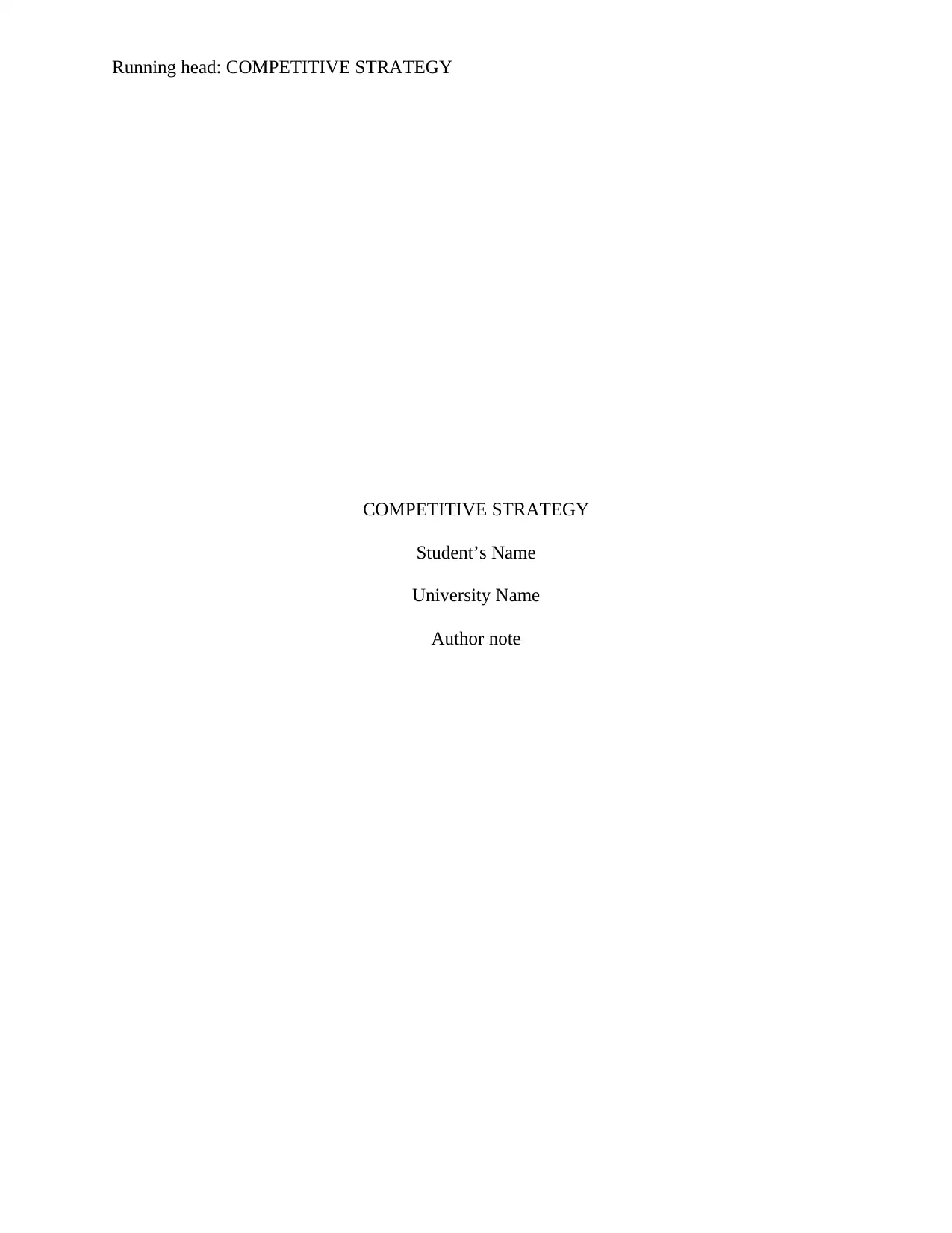
Running head: COMPETITIVE STRATEGY
COMPETITIVE STRATEGY
Student’s Name
University Name
Author note
COMPETITIVE STRATEGY
Student’s Name
University Name
Author note
Paraphrase This Document
Need a fresh take? Get an instant paraphrase of this document with our AI Paraphraser
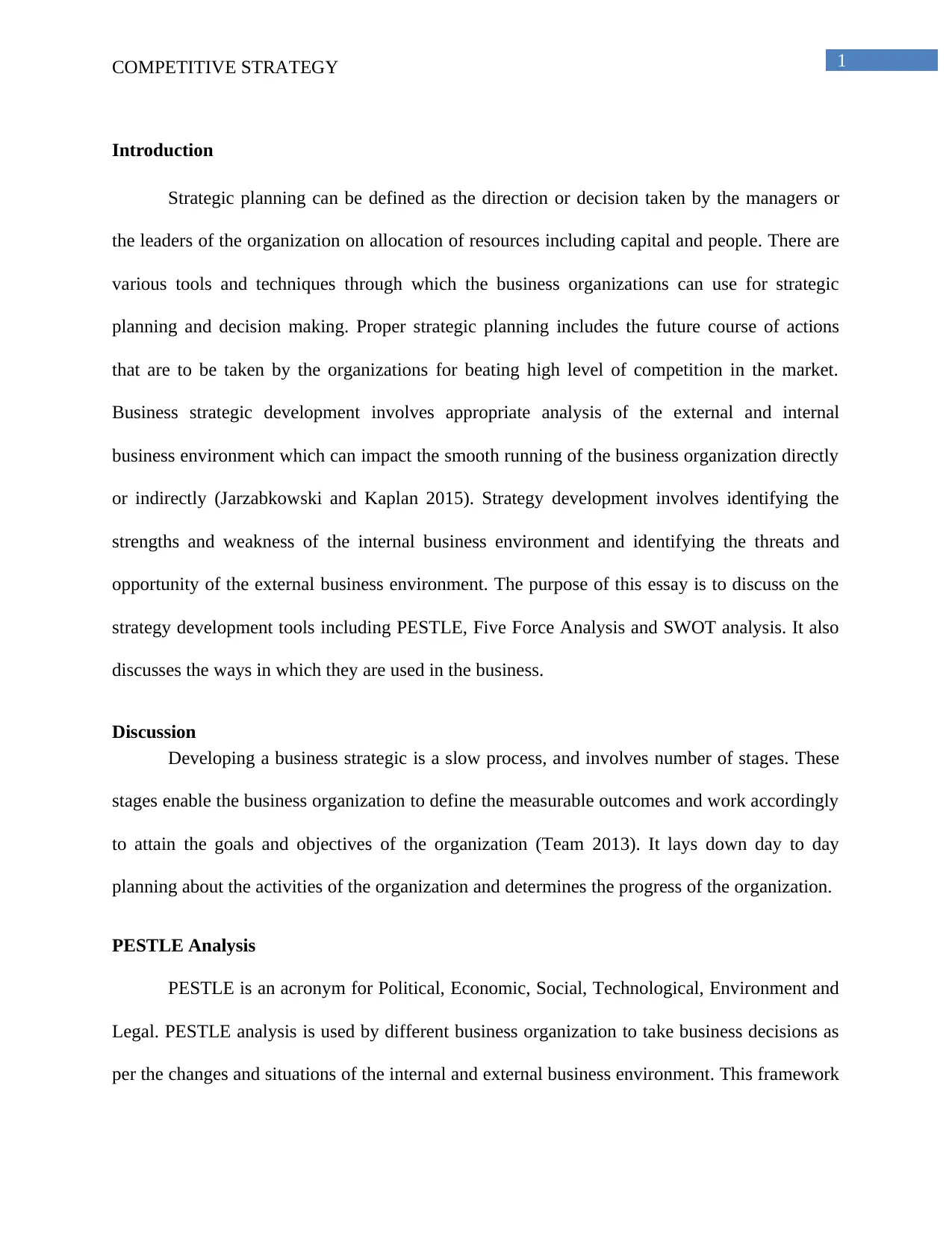
1COMPETITIVE STRATEGY
Introduction
Strategic planning can be defined as the direction or decision taken by the managers or
the leaders of the organization on allocation of resources including capital and people. There are
various tools and techniques through which the business organizations can use for strategic
planning and decision making. Proper strategic planning includes the future course of actions
that are to be taken by the organizations for beating high level of competition in the market.
Business strategic development involves appropriate analysis of the external and internal
business environment which can impact the smooth running of the business organization directly
or indirectly (Jarzabkowski and Kaplan 2015). Strategy development involves identifying the
strengths and weakness of the internal business environment and identifying the threats and
opportunity of the external business environment. The purpose of this essay is to discuss on the
strategy development tools including PESTLE, Five Force Analysis and SWOT analysis. It also
discusses the ways in which they are used in the business.
Discussion
Developing a business strategic is a slow process, and involves number of stages. These
stages enable the business organization to define the measurable outcomes and work accordingly
to attain the goals and objectives of the organization (Team 2013). It lays down day to day
planning about the activities of the organization and determines the progress of the organization.
PESTLE Analysis
PESTLE is an acronym for Political, Economic, Social, Technological, Environment and
Legal. PESTLE analysis is used by different business organization to take business decisions as
per the changes and situations of the internal and external business environment. This framework
Introduction
Strategic planning can be defined as the direction or decision taken by the managers or
the leaders of the organization on allocation of resources including capital and people. There are
various tools and techniques through which the business organizations can use for strategic
planning and decision making. Proper strategic planning includes the future course of actions
that are to be taken by the organizations for beating high level of competition in the market.
Business strategic development involves appropriate analysis of the external and internal
business environment which can impact the smooth running of the business organization directly
or indirectly (Jarzabkowski and Kaplan 2015). Strategy development involves identifying the
strengths and weakness of the internal business environment and identifying the threats and
opportunity of the external business environment. The purpose of this essay is to discuss on the
strategy development tools including PESTLE, Five Force Analysis and SWOT analysis. It also
discusses the ways in which they are used in the business.
Discussion
Developing a business strategic is a slow process, and involves number of stages. These
stages enable the business organization to define the measurable outcomes and work accordingly
to attain the goals and objectives of the organization (Team 2013). It lays down day to day
planning about the activities of the organization and determines the progress of the organization.
PESTLE Analysis
PESTLE is an acronym for Political, Economic, Social, Technological, Environment and
Legal. PESTLE analysis is used by different business organization to take business decisions as
per the changes and situations of the internal and external business environment. This framework
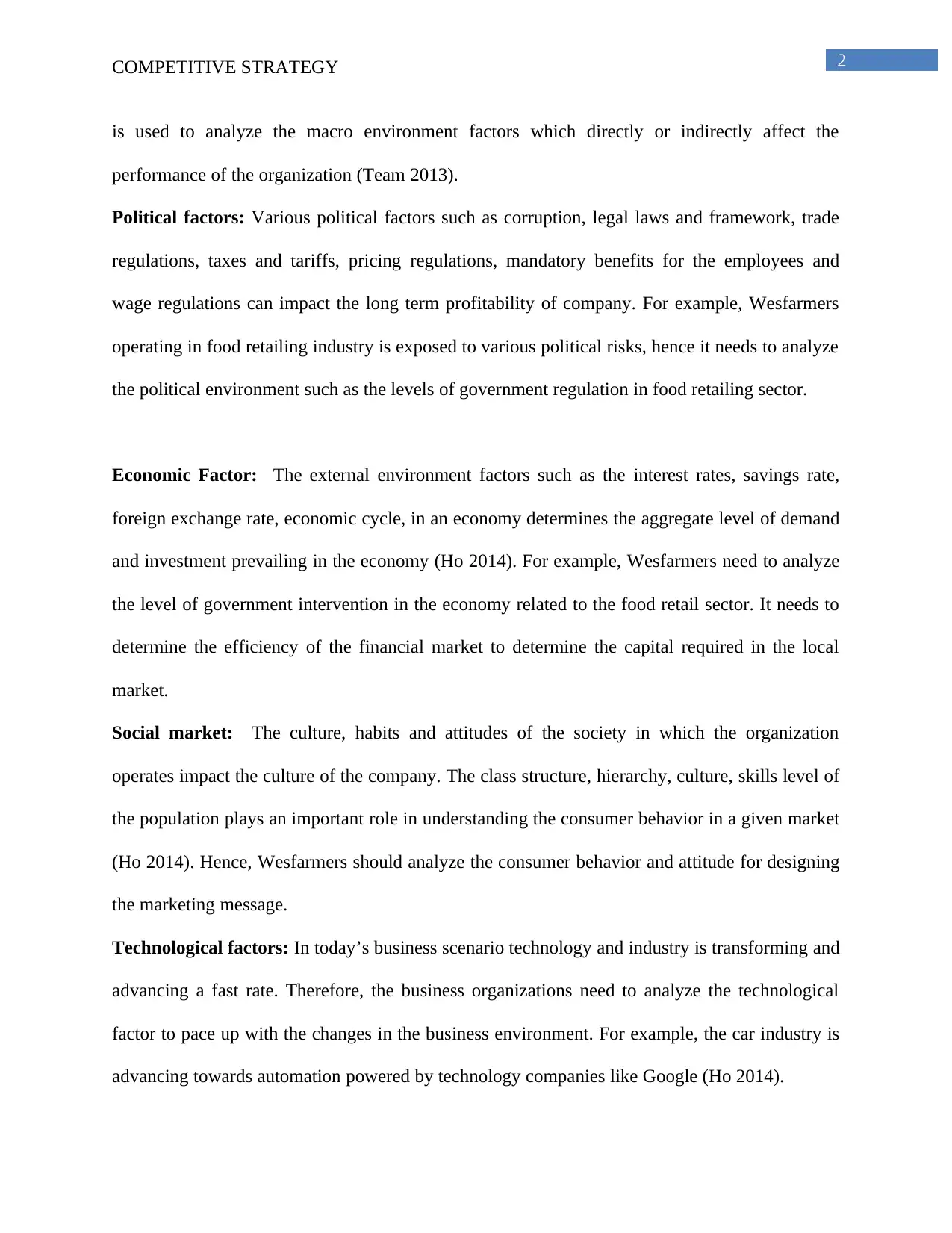
2COMPETITIVE STRATEGY
is used to analyze the macro environment factors which directly or indirectly affect the
performance of the organization (Team 2013).
Political factors: Various political factors such as corruption, legal laws and framework, trade
regulations, taxes and tariffs, pricing regulations, mandatory benefits for the employees and
wage regulations can impact the long term profitability of company. For example, Wesfarmers
operating in food retailing industry is exposed to various political risks, hence it needs to analyze
the political environment such as the levels of government regulation in food retailing sector.
Economic Factor: The external environment factors such as the interest rates, savings rate,
foreign exchange rate, economic cycle, in an economy determines the aggregate level of demand
and investment prevailing in the economy (Ho 2014). For example, Wesfarmers need to analyze
the level of government intervention in the economy related to the food retail sector. It needs to
determine the efficiency of the financial market to determine the capital required in the local
market.
Social market: The culture, habits and attitudes of the society in which the organization
operates impact the culture of the company. The class structure, hierarchy, culture, skills level of
the population plays an important role in understanding the consumer behavior in a given market
(Ho 2014). Hence, Wesfarmers should analyze the consumer behavior and attitude for designing
the marketing message.
Technological factors: In today’s business scenario technology and industry is transforming and
advancing a fast rate. Therefore, the business organizations need to analyze the technological
factor to pace up with the changes in the business environment. For example, the car industry is
advancing towards automation powered by technology companies like Google (Ho 2014).
is used to analyze the macro environment factors which directly or indirectly affect the
performance of the organization (Team 2013).
Political factors: Various political factors such as corruption, legal laws and framework, trade
regulations, taxes and tariffs, pricing regulations, mandatory benefits for the employees and
wage regulations can impact the long term profitability of company. For example, Wesfarmers
operating in food retailing industry is exposed to various political risks, hence it needs to analyze
the political environment such as the levels of government regulation in food retailing sector.
Economic Factor: The external environment factors such as the interest rates, savings rate,
foreign exchange rate, economic cycle, in an economy determines the aggregate level of demand
and investment prevailing in the economy (Ho 2014). For example, Wesfarmers need to analyze
the level of government intervention in the economy related to the food retail sector. It needs to
determine the efficiency of the financial market to determine the capital required in the local
market.
Social market: The culture, habits and attitudes of the society in which the organization
operates impact the culture of the company. The class structure, hierarchy, culture, skills level of
the population plays an important role in understanding the consumer behavior in a given market
(Ho 2014). Hence, Wesfarmers should analyze the consumer behavior and attitude for designing
the marketing message.
Technological factors: In today’s business scenario technology and industry is transforming and
advancing a fast rate. Therefore, the business organizations need to analyze the technological
factor to pace up with the changes in the business environment. For example, the car industry is
advancing towards automation powered by technology companies like Google (Ho 2014).
⊘ This is a preview!⊘
Do you want full access?
Subscribe today to unlock all pages.

Trusted by 1+ million students worldwide
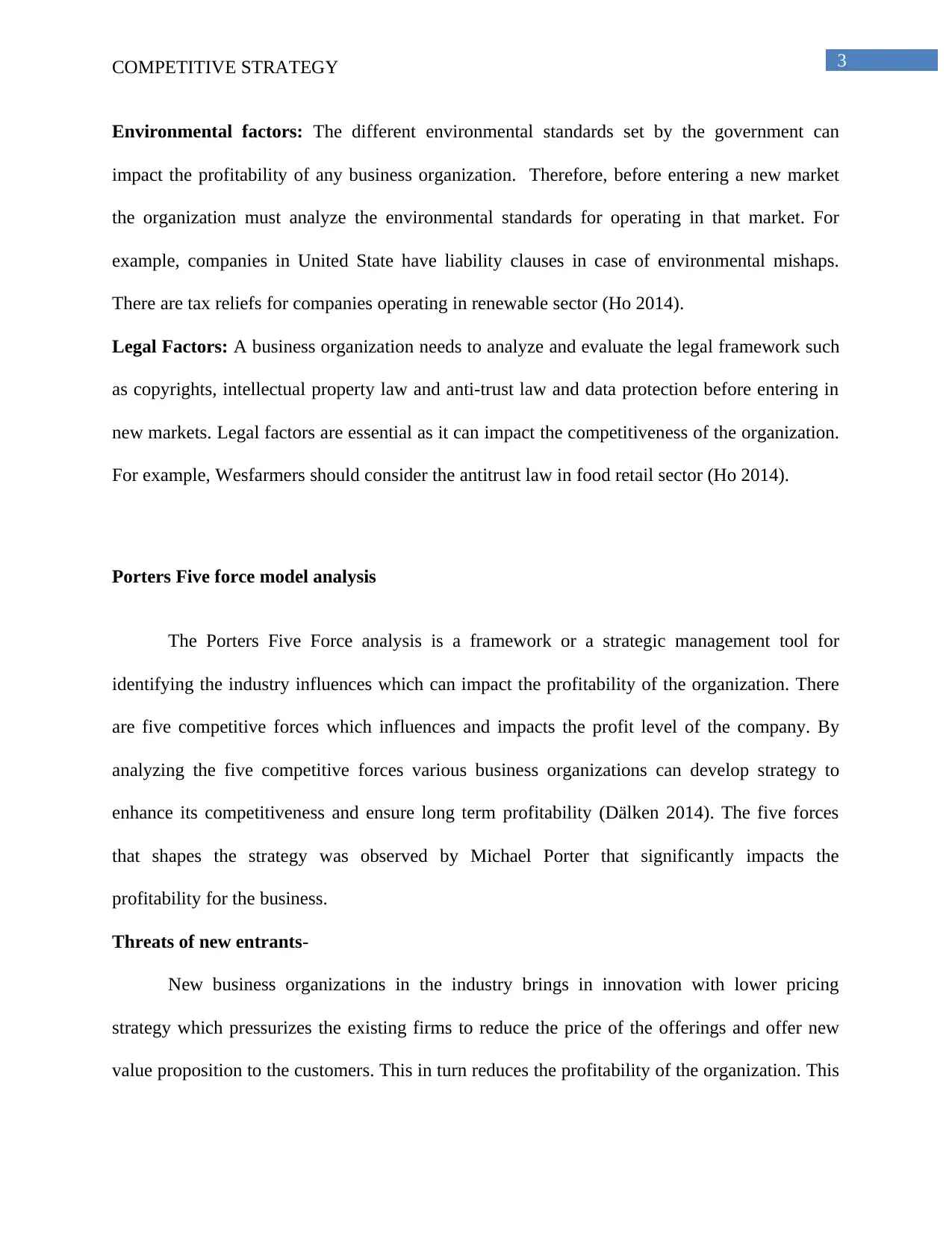
3COMPETITIVE STRATEGY
Environmental factors: The different environmental standards set by the government can
impact the profitability of any business organization. Therefore, before entering a new market
the organization must analyze the environmental standards for operating in that market. For
example, companies in United State have liability clauses in case of environmental mishaps.
There are tax reliefs for companies operating in renewable sector (Ho 2014).
Legal Factors: A business organization needs to analyze and evaluate the legal framework such
as copyrights, intellectual property law and anti-trust law and data protection before entering in
new markets. Legal factors are essential as it can impact the competitiveness of the organization.
For example, Wesfarmers should consider the antitrust law in food retail sector (Ho 2014).
Porters Five force model analysis
The Porters Five Force analysis is a framework or a strategic management tool for
identifying the industry influences which can impact the profitability of the organization. There
are five competitive forces which influences and impacts the profit level of the company. By
analyzing the five competitive forces various business organizations can develop strategy to
enhance its competitiveness and ensure long term profitability (Dälken 2014). The five forces
that shapes the strategy was observed by Michael Porter that significantly impacts the
profitability for the business.
Threats of new entrants-
New business organizations in the industry brings in innovation with lower pricing
strategy which pressurizes the existing firms to reduce the price of the offerings and offer new
value proposition to the customers. This in turn reduces the profitability of the organization. This
Environmental factors: The different environmental standards set by the government can
impact the profitability of any business organization. Therefore, before entering a new market
the organization must analyze the environmental standards for operating in that market. For
example, companies in United State have liability clauses in case of environmental mishaps.
There are tax reliefs for companies operating in renewable sector (Ho 2014).
Legal Factors: A business organization needs to analyze and evaluate the legal framework such
as copyrights, intellectual property law and anti-trust law and data protection before entering in
new markets. Legal factors are essential as it can impact the competitiveness of the organization.
For example, Wesfarmers should consider the antitrust law in food retail sector (Ho 2014).
Porters Five force model analysis
The Porters Five Force analysis is a framework or a strategic management tool for
identifying the industry influences which can impact the profitability of the organization. There
are five competitive forces which influences and impacts the profit level of the company. By
analyzing the five competitive forces various business organizations can develop strategy to
enhance its competitiveness and ensure long term profitability (Dälken 2014). The five forces
that shapes the strategy was observed by Michael Porter that significantly impacts the
profitability for the business.
Threats of new entrants-
New business organizations in the industry brings in innovation with lower pricing
strategy which pressurizes the existing firms to reduce the price of the offerings and offer new
value proposition to the customers. This in turn reduces the profitability of the organization. This
Paraphrase This Document
Need a fresh take? Get an instant paraphrase of this document with our AI Paraphraser
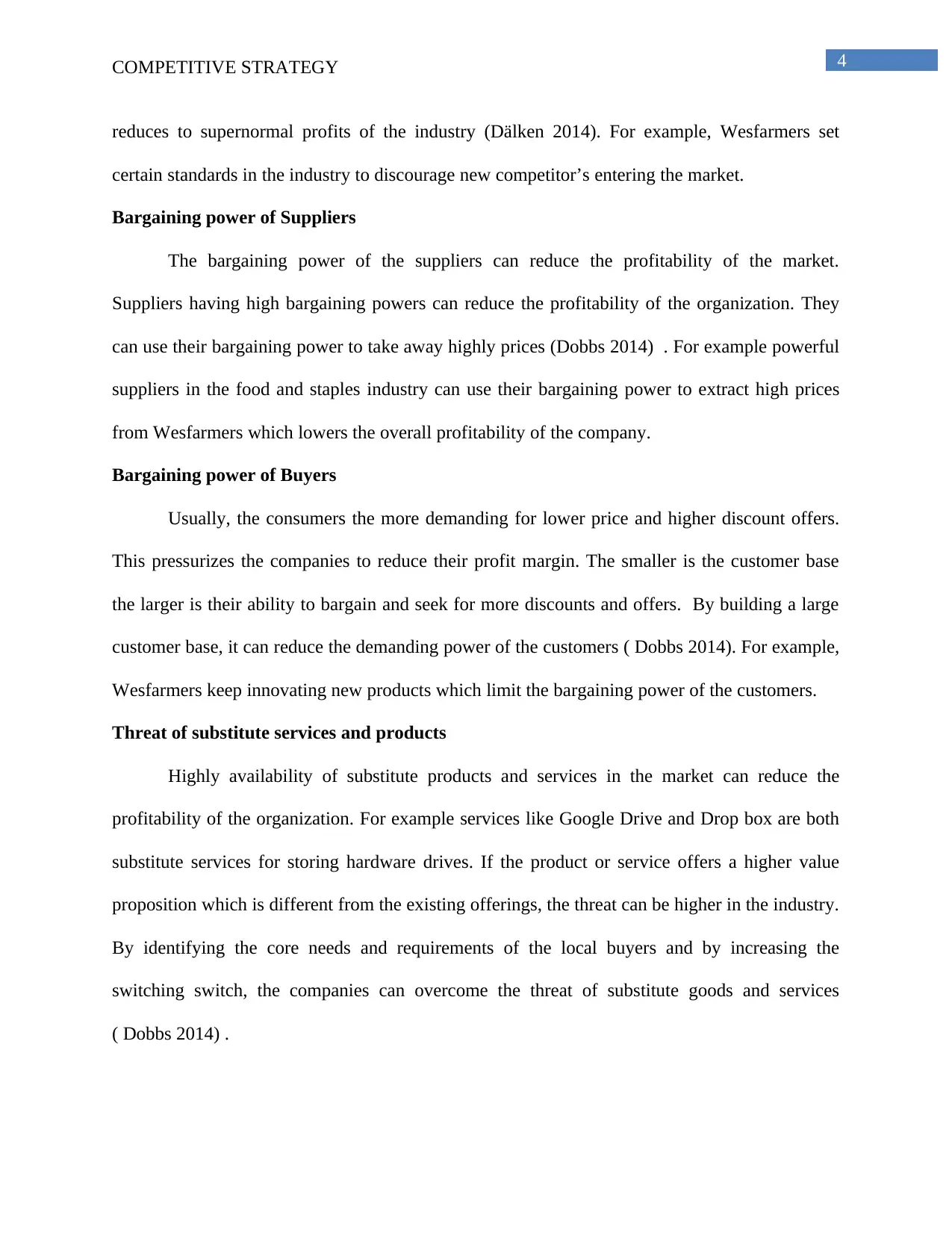
4COMPETITIVE STRATEGY
reduces to supernormal profits of the industry (Dälken 2014). For example, Wesfarmers set
certain standards in the industry to discourage new competitor’s entering the market.
Bargaining power of Suppliers
The bargaining power of the suppliers can reduce the profitability of the market.
Suppliers having high bargaining powers can reduce the profitability of the organization. They
can use their bargaining power to take away highly prices (Dobbs 2014) . For example powerful
suppliers in the food and staples industry can use their bargaining power to extract high prices
from Wesfarmers which lowers the overall profitability of the company.
Bargaining power of Buyers
Usually, the consumers the more demanding for lower price and higher discount offers.
This pressurizes the companies to reduce their profit margin. The smaller is the customer base
the larger is their ability to bargain and seek for more discounts and offers. By building a large
customer base, it can reduce the demanding power of the customers ( Dobbs 2014). For example,
Wesfarmers keep innovating new products which limit the bargaining power of the customers.
Threat of substitute services and products
Highly availability of substitute products and services in the market can reduce the
profitability of the organization. For example services like Google Drive and Drop box are both
substitute services for storing hardware drives. If the product or service offers a higher value
proposition which is different from the existing offerings, the threat can be higher in the industry.
By identifying the core needs and requirements of the local buyers and by increasing the
switching switch, the companies can overcome the threat of substitute goods and services
( Dobbs 2014) .
reduces to supernormal profits of the industry (Dälken 2014). For example, Wesfarmers set
certain standards in the industry to discourage new competitor’s entering the market.
Bargaining power of Suppliers
The bargaining power of the suppliers can reduce the profitability of the market.
Suppliers having high bargaining powers can reduce the profitability of the organization. They
can use their bargaining power to take away highly prices (Dobbs 2014) . For example powerful
suppliers in the food and staples industry can use their bargaining power to extract high prices
from Wesfarmers which lowers the overall profitability of the company.
Bargaining power of Buyers
Usually, the consumers the more demanding for lower price and higher discount offers.
This pressurizes the companies to reduce their profit margin. The smaller is the customer base
the larger is their ability to bargain and seek for more discounts and offers. By building a large
customer base, it can reduce the demanding power of the customers ( Dobbs 2014). For example,
Wesfarmers keep innovating new products which limit the bargaining power of the customers.
Threat of substitute services and products
Highly availability of substitute products and services in the market can reduce the
profitability of the organization. For example services like Google Drive and Drop box are both
substitute services for storing hardware drives. If the product or service offers a higher value
proposition which is different from the existing offerings, the threat can be higher in the industry.
By identifying the core needs and requirements of the local buyers and by increasing the
switching switch, the companies can overcome the threat of substitute goods and services
( Dobbs 2014) .
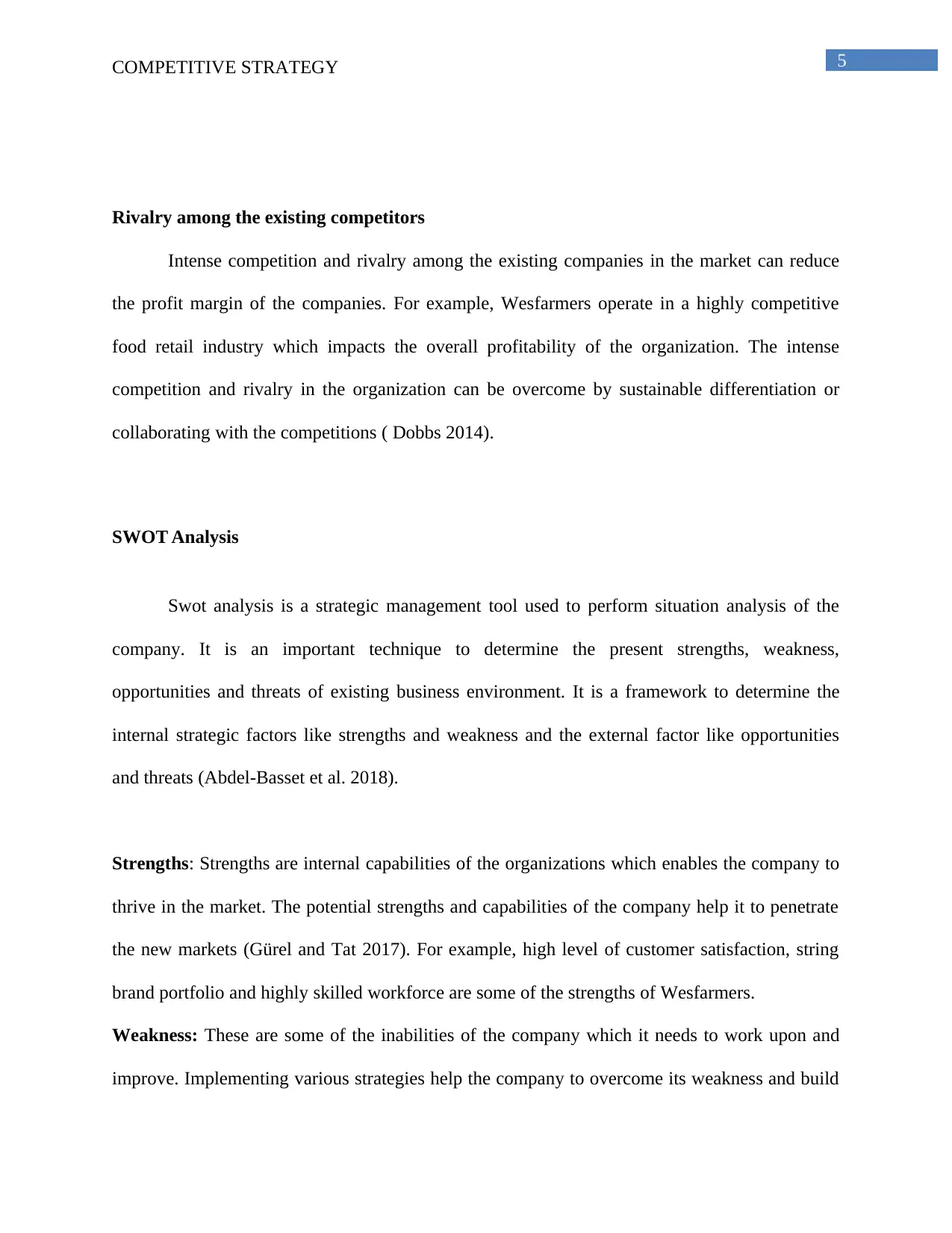
5COMPETITIVE STRATEGY
Rivalry among the existing competitors
Intense competition and rivalry among the existing companies in the market can reduce
the profit margin of the companies. For example, Wesfarmers operate in a highly competitive
food retail industry which impacts the overall profitability of the organization. The intense
competition and rivalry in the organization can be overcome by sustainable differentiation or
collaborating with the competitions ( Dobbs 2014).
SWOT Analysis
Swot analysis is a strategic management tool used to perform situation analysis of the
company. It is an important technique to determine the present strengths, weakness,
opportunities and threats of existing business environment. It is a framework to determine the
internal strategic factors like strengths and weakness and the external factor like opportunities
and threats (Abdel-Basset et al. 2018).
Strengths: Strengths are internal capabilities of the organizations which enables the company to
thrive in the market. The potential strengths and capabilities of the company help it to penetrate
the new markets (Gürel and Tat 2017). For example, high level of customer satisfaction, string
brand portfolio and highly skilled workforce are some of the strengths of Wesfarmers.
Weakness: These are some of the inabilities of the company which it needs to work upon and
improve. Implementing various strategies help the company to overcome its weakness and build
Rivalry among the existing competitors
Intense competition and rivalry among the existing companies in the market can reduce
the profit margin of the companies. For example, Wesfarmers operate in a highly competitive
food retail industry which impacts the overall profitability of the organization. The intense
competition and rivalry in the organization can be overcome by sustainable differentiation or
collaborating with the competitions ( Dobbs 2014).
SWOT Analysis
Swot analysis is a strategic management tool used to perform situation analysis of the
company. It is an important technique to determine the present strengths, weakness,
opportunities and threats of existing business environment. It is a framework to determine the
internal strategic factors like strengths and weakness and the external factor like opportunities
and threats (Abdel-Basset et al. 2018).
Strengths: Strengths are internal capabilities of the organizations which enables the company to
thrive in the market. The potential strengths and capabilities of the company help it to penetrate
the new markets (Gürel and Tat 2017). For example, high level of customer satisfaction, string
brand portfolio and highly skilled workforce are some of the strengths of Wesfarmers.
Weakness: These are some of the inabilities of the company which it needs to work upon and
improve. Implementing various strategies help the company to overcome its weakness and build
⊘ This is a preview!⊘
Do you want full access?
Subscribe today to unlock all pages.

Trusted by 1+ million students worldwide
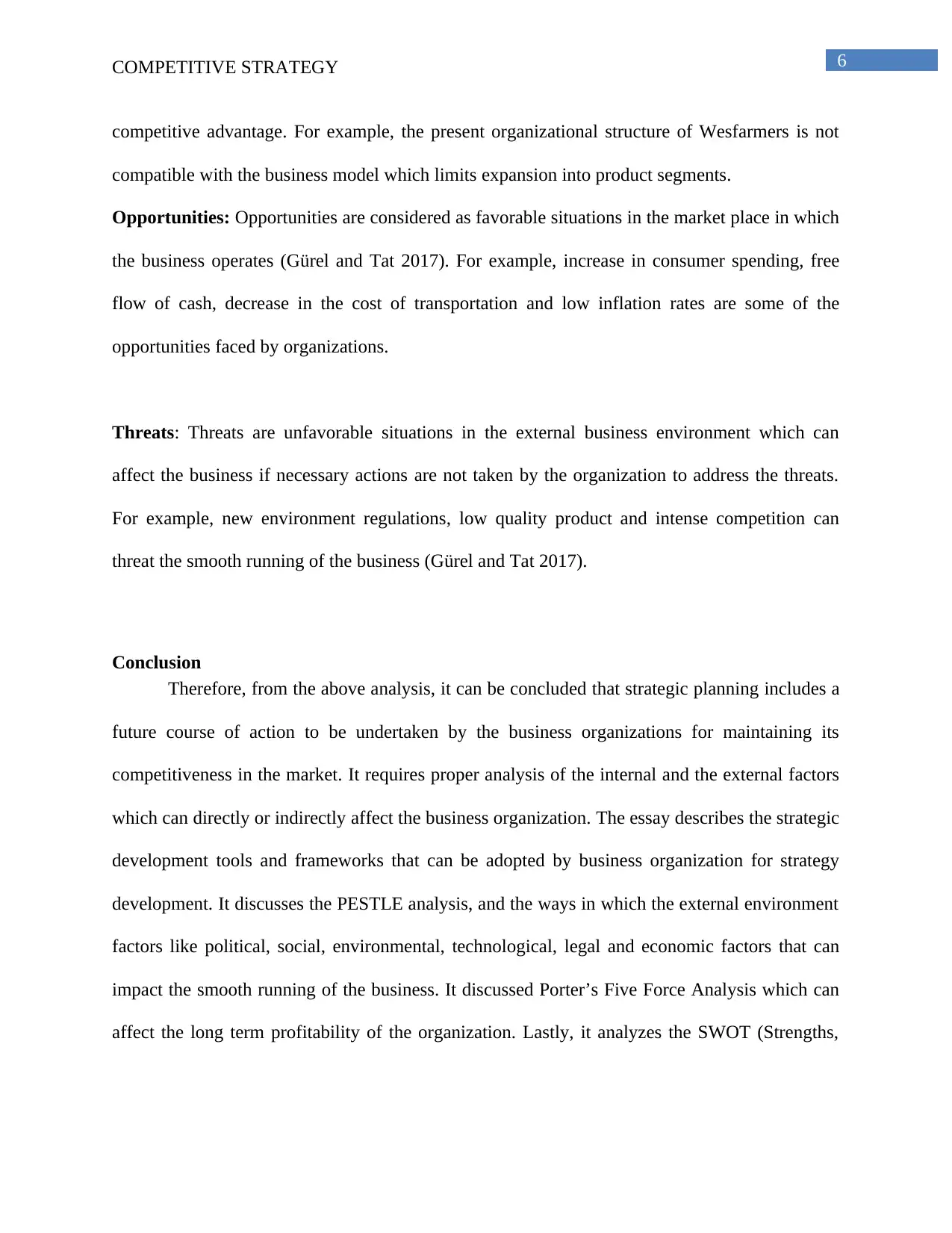
6COMPETITIVE STRATEGY
competitive advantage. For example, the present organizational structure of Wesfarmers is not
compatible with the business model which limits expansion into product segments.
Opportunities: Opportunities are considered as favorable situations in the market place in which
the business operates (Gürel and Tat 2017). For example, increase in consumer spending, free
flow of cash, decrease in the cost of transportation and low inflation rates are some of the
opportunities faced by organizations.
Threats: Threats are unfavorable situations in the external business environment which can
affect the business if necessary actions are not taken by the organization to address the threats.
For example, new environment regulations, low quality product and intense competition can
threat the smooth running of the business (Gürel and Tat 2017).
Conclusion
Therefore, from the above analysis, it can be concluded that strategic planning includes a
future course of action to be undertaken by the business organizations for maintaining its
competitiveness in the market. It requires proper analysis of the internal and the external factors
which can directly or indirectly affect the business organization. The essay describes the strategic
development tools and frameworks that can be adopted by business organization for strategy
development. It discusses the PESTLE analysis, and the ways in which the external environment
factors like political, social, environmental, technological, legal and economic factors that can
impact the smooth running of the business. It discussed Porter’s Five Force Analysis which can
affect the long term profitability of the organization. Lastly, it analyzes the SWOT (Strengths,
competitive advantage. For example, the present organizational structure of Wesfarmers is not
compatible with the business model which limits expansion into product segments.
Opportunities: Opportunities are considered as favorable situations in the market place in which
the business operates (Gürel and Tat 2017). For example, increase in consumer spending, free
flow of cash, decrease in the cost of transportation and low inflation rates are some of the
opportunities faced by organizations.
Threats: Threats are unfavorable situations in the external business environment which can
affect the business if necessary actions are not taken by the organization to address the threats.
For example, new environment regulations, low quality product and intense competition can
threat the smooth running of the business (Gürel and Tat 2017).
Conclusion
Therefore, from the above analysis, it can be concluded that strategic planning includes a
future course of action to be undertaken by the business organizations for maintaining its
competitiveness in the market. It requires proper analysis of the internal and the external factors
which can directly or indirectly affect the business organization. The essay describes the strategic
development tools and frameworks that can be adopted by business organization for strategy
development. It discusses the PESTLE analysis, and the ways in which the external environment
factors like political, social, environmental, technological, legal and economic factors that can
impact the smooth running of the business. It discussed Porter’s Five Force Analysis which can
affect the long term profitability of the organization. Lastly, it analyzes the SWOT (Strengths,
Paraphrase This Document
Need a fresh take? Get an instant paraphrase of this document with our AI Paraphraser
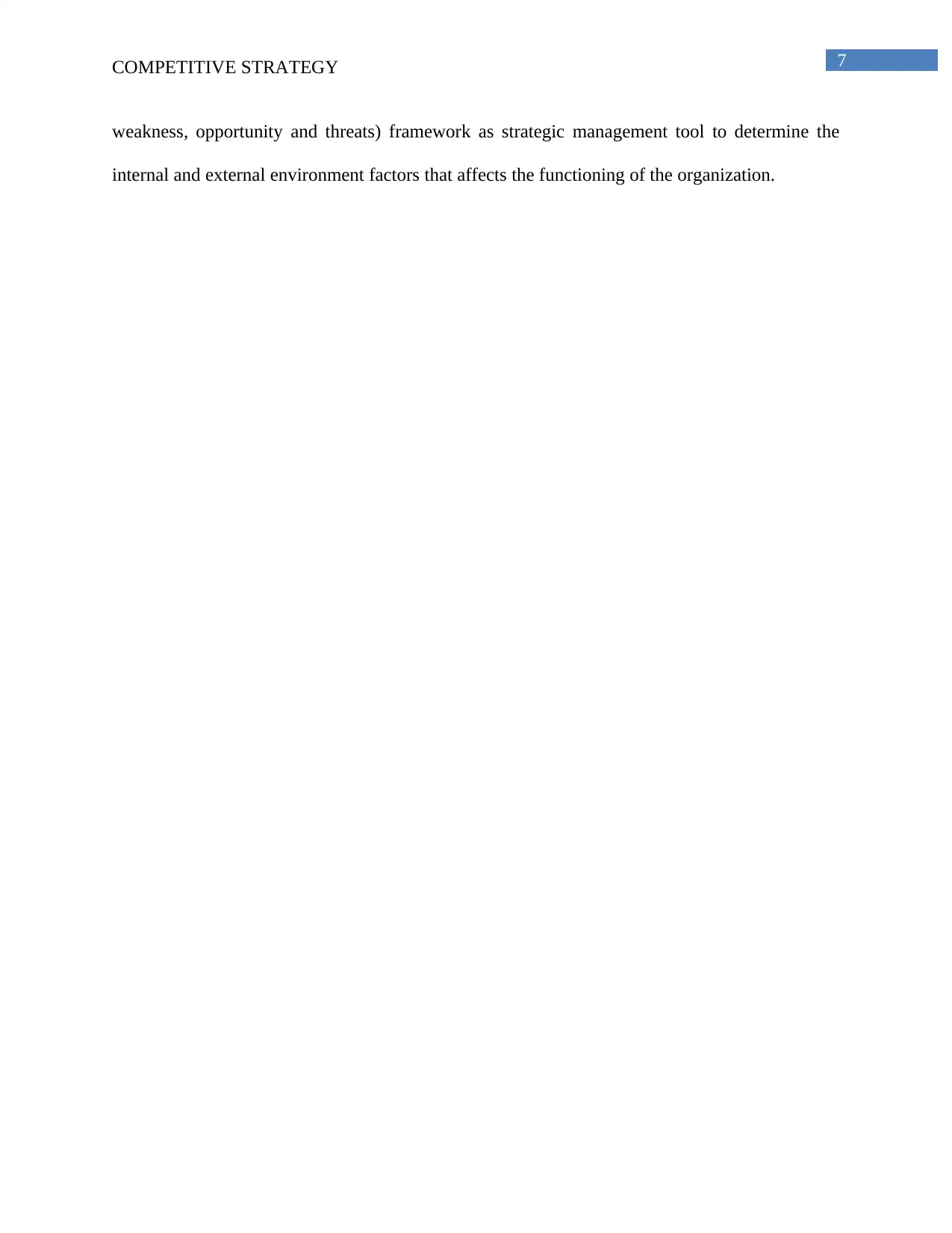
7COMPETITIVE STRATEGY
weakness, opportunity and threats) framework as strategic management tool to determine the
internal and external environment factors that affects the functioning of the organization.
weakness, opportunity and threats) framework as strategic management tool to determine the
internal and external environment factors that affects the functioning of the organization.
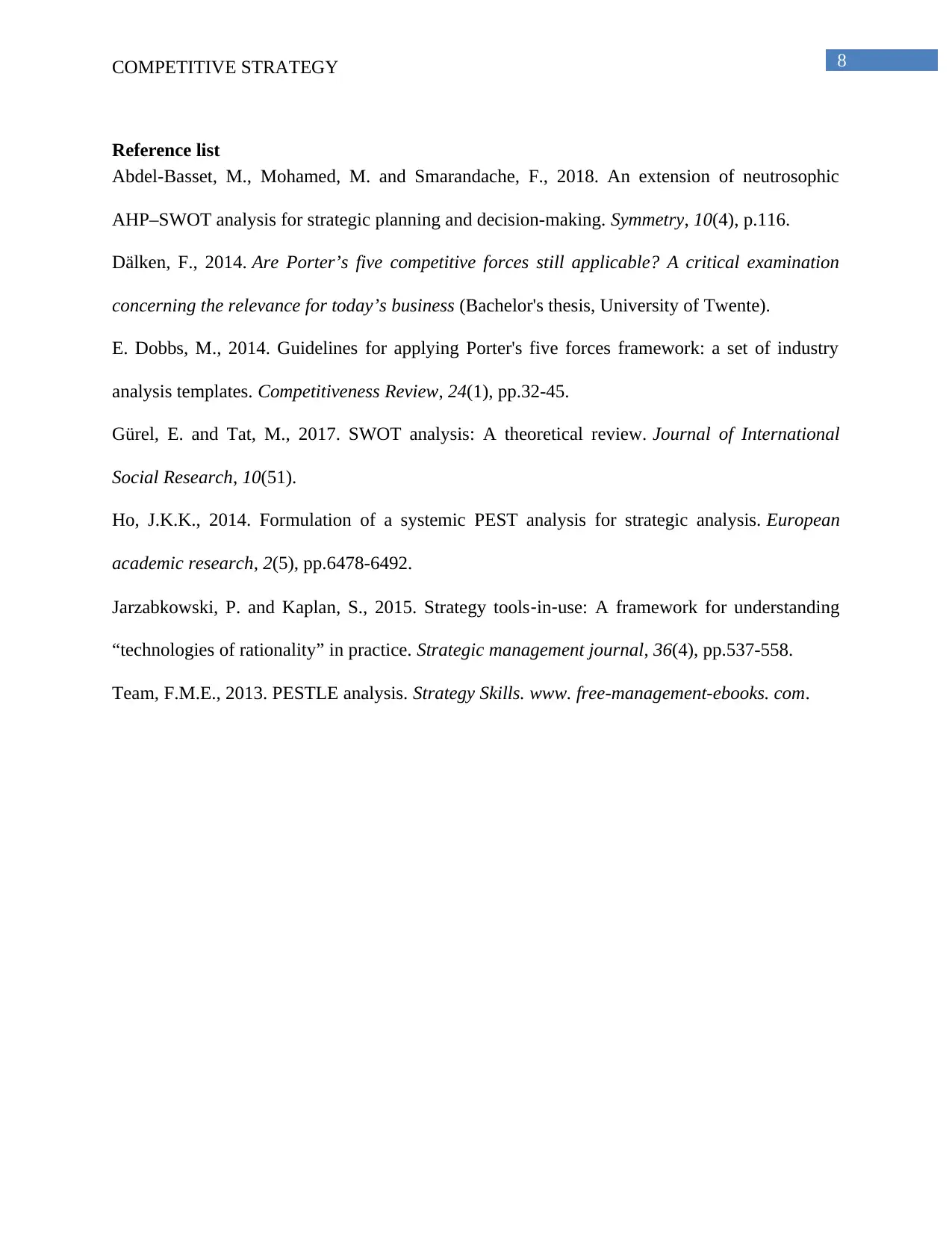
8COMPETITIVE STRATEGY
Reference list
Abdel-Basset, M., Mohamed, M. and Smarandache, F., 2018. An extension of neutrosophic
AHP–SWOT analysis for strategic planning and decision-making. Symmetry, 10(4), p.116.
Dälken, F., 2014. Are Porter’s five competitive forces still applicable? A critical examination
concerning the relevance for today’s business (Bachelor's thesis, University of Twente).
E. Dobbs, M., 2014. Guidelines for applying Porter's five forces framework: a set of industry
analysis templates. Competitiveness Review, 24(1), pp.32-45.
Gürel, E. and Tat, M., 2017. SWOT analysis: A theoretical review. Journal of International
Social Research, 10(51).
Ho, J.K.K., 2014. Formulation of a systemic PEST analysis for strategic analysis. European
academic research, 2(5), pp.6478-6492.
Jarzabkowski, P. and Kaplan, S., 2015. Strategy tools‐in‐use: A framework for understanding
“technologies of rationality” in practice. Strategic management journal, 36(4), pp.537-558.
Team, F.M.E., 2013. PESTLE analysis. Strategy Skills. www. free-management-ebooks. com.
Reference list
Abdel-Basset, M., Mohamed, M. and Smarandache, F., 2018. An extension of neutrosophic
AHP–SWOT analysis for strategic planning and decision-making. Symmetry, 10(4), p.116.
Dälken, F., 2014. Are Porter’s five competitive forces still applicable? A critical examination
concerning the relevance for today’s business (Bachelor's thesis, University of Twente).
E. Dobbs, M., 2014. Guidelines for applying Porter's five forces framework: a set of industry
analysis templates. Competitiveness Review, 24(1), pp.32-45.
Gürel, E. and Tat, M., 2017. SWOT analysis: A theoretical review. Journal of International
Social Research, 10(51).
Ho, J.K.K., 2014. Formulation of a systemic PEST analysis for strategic analysis. European
academic research, 2(5), pp.6478-6492.
Jarzabkowski, P. and Kaplan, S., 2015. Strategy tools‐in‐use: A framework for understanding
“technologies of rationality” in practice. Strategic management journal, 36(4), pp.537-558.
Team, F.M.E., 2013. PESTLE analysis. Strategy Skills. www. free-management-ebooks. com.
⊘ This is a preview!⊘
Do you want full access?
Subscribe today to unlock all pages.

Trusted by 1+ million students worldwide
1 out of 9
Related Documents
Your All-in-One AI-Powered Toolkit for Academic Success.
+13062052269
info@desklib.com
Available 24*7 on WhatsApp / Email
![[object Object]](/_next/static/media/star-bottom.7253800d.svg)
Unlock your academic potential
Copyright © 2020–2025 A2Z Services. All Rights Reserved. Developed and managed by ZUCOL.





